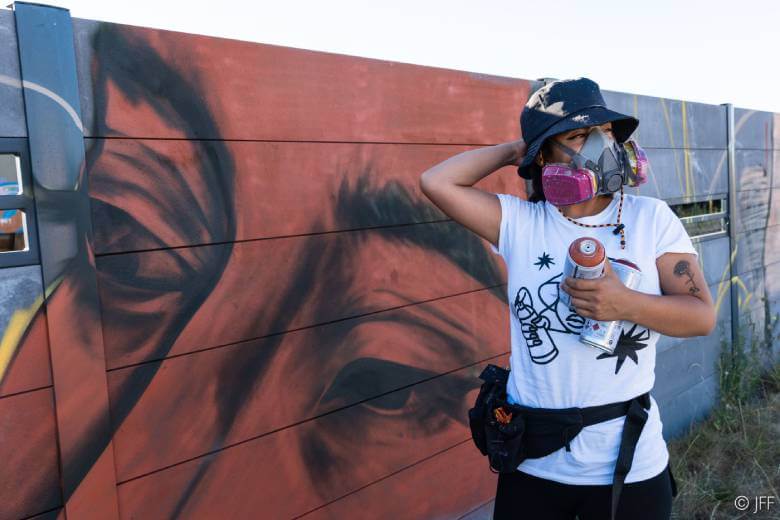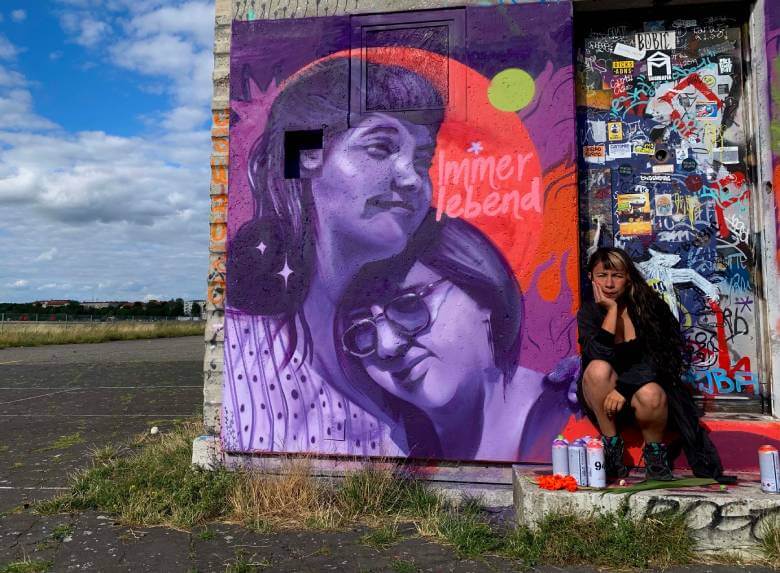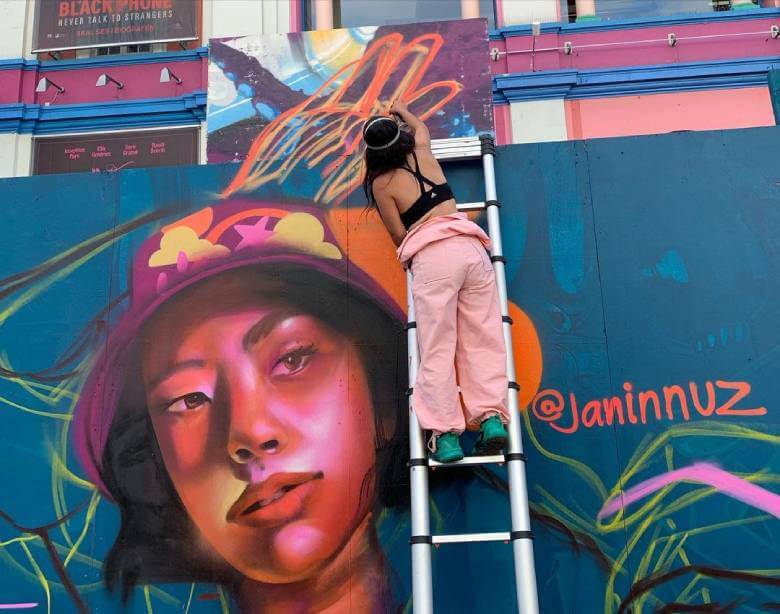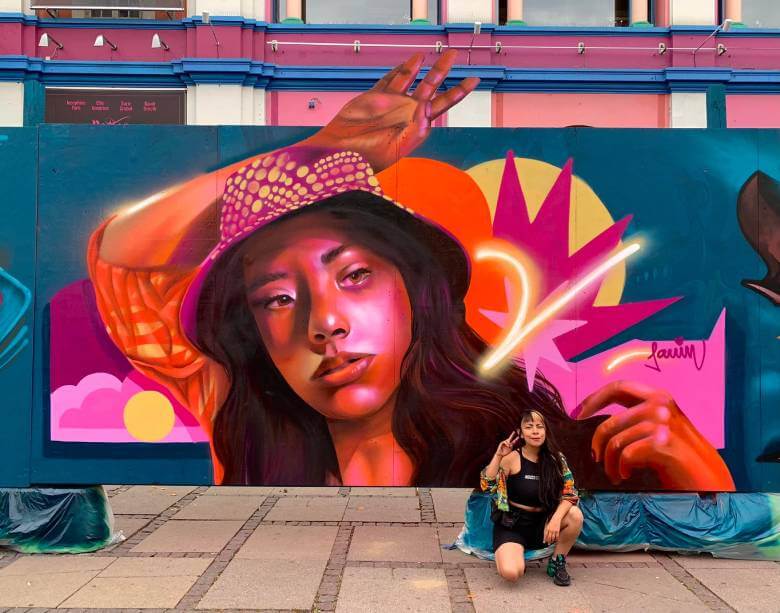
Janin Nuz is an artist and activist from Mexico. Her signature characters draw influence from a background in graffiti combined with the vibrant colors and fonts of signwriters from her native country. She uses her platform to comment on social issues that affect her and her community at large, and she was in Europe recently to spread her message.
MTN World talked to Janin just after the end of her trip.
So Janin, where are you from?
I am from San Luis de Potosí, a city in northern Mexico in the desert. It’s an area in the middle of Mexico.
‘I come from the outskirts of the city, and that was my first taste of graffiti. Before visiting a museum, I saw murals. So that’s how I started getting to know the people who’d painted.’

How did you get into muralism, art and graffiti?
I’m a graphic designer. Since I was a child, I wanted to draw. And I’m a curious person. Once I was walking along and I saw a guy spray painting a mural and it blew my mind. I thought, “I want to do that too.” I never saw the piece again, but that was my first encounter with murals.
Then I met the same guy at college and we became best friends. So, when his crew painted, I told them to invite me to watch. So I was doing a degree as a designer, but at the same time I was learning in the street how to paint walls, how to mix paint.
I started painting about 11 years ago. There weren’t a lot of aerosols back then, a lot of them were hardware brands. We had to mix colors and we still do. It was like that in my city, but in reality there weren’t many of us. It’s an industrial city and there’s not much support for culture. There’s a lot of illegal graff because there are just no spaces for expression. That’s why there are lots of people bombing.
I began to paint large formats and realized that painting murals in the street has a different aim to studio work or computer design. Walls have a connection with people passing by. I connected a lot with the street.
I come from the outskirts of the city, and that was my first taste of graffiti. Before visiting a museum, I saw murals. So that’s how I started getting to know the people who’d painted. Then I started traveling a little bit to festivals and getting to know Mexico, because before, Facebook or social networks weren’t used as much, and we connected through events or seeing other people’s work in person.

‘I think most graffiti artists are self-taught, they learn to paint through graffiti or urban art. Then they begin to soak up the history of muralism in Mexico. It’s something that gave energy to the scene, because there is a lot of tradition.’
I’d like to know how you think traditional Mexican muralism may have influenced your art or the graffiti and street art scene in general – is there a connection, in your opinion?
Yes, totally. I think that people began to paint in the same way as before. There’s history before us, we’ve learned from the muralism of great artists like Siqueiros and Diego Rivera. They talked about Mexico and what was happening. So we have taken up those political and social discourses to speak about what is happening in Mexico today through graffiti.
We also learned a lot technically from those murals. I think most graffiti artists are self-taught, they learn to paint through graffiti or urban art. Then they begin to soak up the history of muralism in Mexico. It’s something that gave energy to the scene, because there is a lot of tradition. It’s something of great importance in our world: they were the first people to paint these large formats and our museums and libraries are full of their work. There are murals everywhere.
So even though we didn’t always fully understand muralism, we saw it when we went to the library, when we went to museums. So yes, I see a very strong connection between muralism and what we are doing now.

Do you think there is more tolerance for art in public spaces thanks to these murals?
I think so, now. But 10 years ago, when I started to paint, they still yelled at us in the street. There wasn’t so much tolerance because there were many people bombing.
It’s also significant that there’s been a worldwide boom in, graffiti, urban and street art and and that people are beginning to have more exposure. In Mexico, people are now more educated than at any point in our history. Kids at school are beginning to learn about muralism and many of us are even in the history books in primary schools – many graffiti artists, many muralists. I think that awareness is being raised from there.
It’s a history that must be preserved. The streets also talk about it. And brands too. Huge collaborations have been done with brands; it’s making people accept the tradition. I think that now there is more awareness because we’ve dedicated our lives to painting and there’s also more support from the government and other institutions. There are projects that are paid which is good because culture in Mexico is very precarious. It’s hard to leave our country to work.

You were able to visit Europe this summer, right? How was the experience?
It was my first time. I’ve traveled to other countries in Latin America, but Europe was a place I worked hard to visit, and it was a super nice experience. Every place I went to, I connected with the people I painted with.
I came across many Mexicans but everyone who I painted with welcomed me with a lot of love. I was really very happy. It’s been a few days since I got back and I still haven’t assimilated what happened because it was such a nice experience. I never imagined that my hands would take me to be able to see other countries, another continent and introduce me to other artists.
Just yesterday I told my boyfriend that I was in the Montana store and how the first MTN store was in Barcelona. I’d never really imagined that my work would take me to see things that were far away.

We met here in Barcelona, but I’ve seen that you were also in Denmark, France and Germany.
Yes, well, my first plan was to go to a festival in Denmark, but later things happened that took me to other countries to paint and meet people and work. It was super nice to be able to get to know those countries through painting.
Like I said, I only had Denmark in mind, but then I contacted Yubia about Barcelona and then Berlin and the route was made, very organically. Projects came up and it was super cool to be able to visit those historically significant places, for example Berlin, with its history, which is now something people are experiencing in my country. The experience of each country was different but I got a lot from each place I visited.

What history does Mexico have in common with Berlin?
The wall. Here we have a wall that divides Mexico from the United States, and every day immigrants die trying to cross that wall. I always say that history must not be forgotten so that it doesn’t repeat itself. It’s very sad to see that this happens, and, in many countries, borders continue to exist and that there are many victims of this.
My country is going through a difficult time with the migration crisis, drug trafficking, and drugs corrupting the government. So there are a lot of things that are happening. That’s why in Berlin I painted a couple of Mexican women embracing. It’s about what’s happening in my country, about the women who are missing. Every day women die, women disappear, there are many femicides.
I think that painting has also helped me to raise awareness and make other people see that something very serious is happening that we can communicate through painting.

Do you receive criticism for what you paint or do people generally support you?
They support me a lot. I think I have a deep connection with people who follow my work that I noticed before coming abroad when I was saving money. I sold paintings and t-shirts. People bought a lot of things from me and supported me for the trip to Europe.
They feel that there is a great need to talk about my topics. There was no criticism, rather an understanding that it was necessary. We need to use all the tools that we have at hand to talk about what people are going through and we reflect through our art.

‘I realized that in reality, urban art and street art in Mexico is powerful because most of my friends are very good at painting. We have technical quality and a strong discourse. I was in a country so far away and I was proud to have such talented friends.’
You were in Copenhagen at the Meeting of Styles event, which is one of the best-known graffiti events in the world. How does your art coexist with graffiti?
Well actually, when the pieces weren’t finished, one night someone painted over our characters, they crossed out the faces. I thought, “too bad”, and everyone hugged me. I thought, “It’s the street, I’m used to these things happening everywhere.” Even in the ‘first world’ disputes continue to happen on the walls.
The next day I was able to fix it easily and people began to congratulate me, I even met a graffiti artist, and he asked me, “How do you feel?” “Great,” I told him. “The diss even helped me to fix some things, and I was happy to do things that I had been afraid to do.” He said “You’re so positive.” I said, “No. It’s because in my country we’re used to solving things however we can, with the tools we have.”
Lots of people liked my wall. I also mixed aerosol colors, because in my country the scene isn’t established, there aren’t many colors. So I mix colors to paint skin with Mexican brands. I was mixing and everyone was like ,“How do you do that?”. And I realized that in reality, urban art and street art in Mexico is powerful because most of my friends are very good at painting. We have technical quality and a strong discourse. I was in a country so far away and I was proud to have such talented friends.
I felt very lucky to have had the opportunity to paint with all these new people. It was lovely to meet them and connect with so many girls, because a lot of my discourse is about women. I was glad to know that there are many women painting and connected. There was a girl from Canada and her roomie was a friend of mine, a girl from Finland turned out to be a friend of a friend. There were super close connections.
I’m on the other side of the world and I still have Mexico close by. Seeing more women painting, different styles, made me think would take what I learned back home so that others could have the same opportunities to travel.
People wrote me messages like, “That’s cool, you’re living the dream!”. There’s a network of women who’ve seen that it can be done. It takes a long time and there’s a lot of work behind everything that happens, but it can be done despite the distances.

A couple of questions to finish. Who would currently be your three favorite artists from urban art, muralism and graffiti?
My three favorites… Well, I really like Yubia. When I began to paint, I saw graffiti in magazines and I’ve always admired her. Another is Tysa Paulina, who’s also from Mexico. She’s one of the influences in my graphics. Another one is Belín, I met him in Mexico and it blew my mind how he handled a spray can and the technique he had.
What they say and what they do make these three artists big influences on my personal history.

Do you have a favorite color?
It changes a lot each season, but I like bluish purple, the mauve. I’m using many purples, Prophet Violet. I use a lot of violets in my palette.
Which cap helps you the most to reproduce things from your imagination?
I use the NY fat cap. It’s amazing how it makes lines. The movement you make when painting is like dancing on a wall.
And what songs do you love to dance to?
Now I really like reggaeton. I like the song “I Went On Vacation” by Bad Bunny, because that song reminds me of many things. In fact, I started writing to Yubia because one day Bad Bunny reposted a story about a wall I painted and Yubia replied with a sad face and I thought she didn’t like my wall but she told me she used the wrong emoji!

Photos: Jean Félix Fallone.
MTN World recently had the chance to interview another Mexican artist, Alina Kiliwa. Check out the conversation here.
Looking for MTN in Mexico? We have stores in Mexico City, Monterrey and Puebla.
2 What do you think?
Add a comment